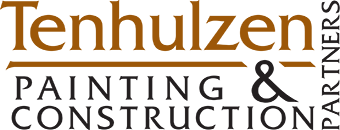What is a “Properly Painted Surface”?
The significance of this topic is so important to our clients, we felt it was time to address the level of standards you should expect from your paint contractor. The Painting and Decorating Contractors or America (PDCA) have created standards designed to govern the level of surface preparation and the resulting finished product. Members of this association are educated time and again on what these standards are and how to ultimately please thier clients by establishing expectations prior to acceptance of a bid to complete the project.
At Tenhulzen Painting, the first thing we look at in evaluating a project is the condition of the surface that will be painted. There are 5 categories that any surface could fall into:
Level 1 – Basic: This surface preparation level requires basic cleanliness of surfaces to ensure the adhesion of new finishes to the surfaces to which they are applied with less concern for the adhesion of existing paint coats and quality of appearance of the finished surfaces. Preparation might include the removal of surface dust, dirt, obvious loose paint and other surface contaminants by washing, light pressure washing, hand cleaning, dusting and/or mildew/mold/algea treatment. This level of preparation should ensure that subsequently applied coats of paint will adhere to existing paint coats. It does not warrant that previously applied paint coatings are well adhered to each other or are well adhered to the substrate itself. Under this level of preparation no alteration of the existing suraface profile shall be performed.
Level 2 – Standard: This surface preparation level requires basic cleanliness of surface to ensure the adhesion of new finishes to the surfaces to which they are applied as well as the examination of existing coatings to assess their adhesion. With this level of surface preparation, good adhesion and longevity of finish is of primary concern and appearance is of secondary concern. This level of surface preparation includes that described in Level 1 plus other procedures necessary to create a sound surface for repainting, including solvent cleaning, basic patching/filling, caulking, light sanding/abrading, and “feather edge” sanding. Under this level of surface preparation, it is recommended that adhesion tests be performed.
Level 3 – Superior: This surface preparation level incorporates the requirements of Levels 1 and 2 with added emphasis on the quality fo the appearance of the painted surfaces. This level of surface preparation includes filling, patching, taping cracks in dyrwall and properly dealing with “nail pops,” approximate matches to existing textures, and thorough sanding to minimize existing runs, sags, brush/roller marks, and the surface profile of cracked and peeling areas, and other existing surface defects. Under this level of preparation the general surface profile is retained but defects causing abrupt surface profile differences exceeding 1/16 inch or 62.5 mils will be corrected.
Level 4 – Supreme: This surface preparation level incorporates the requirements of Levels 1, 2 and 3 with even more emphasis on the quality of appearance of finish painted surfaces. Under this level of surface preparation, all necessary preparation techniques will be employed to improve the quality fo appearance except to the level of Restoration/Resurfacing. Thorough filing and sanding will be accomplished to eliminate defects causing abrupt surface profile differences exceeding 1/32 inch or 31 mils.
Level 5 – Restoration/Resurfacing: This degree of surface preparation is required when existing conditions indicate that the surfaces are severly deteriorarated or there is substrate damage. Existing coatings may be completely, or nearly completely removed. Abrasion, chemical removers or applied heat may be employed in order to remove a failed coating and/or to expose a failing substrate. Substrates may have to be completely replaced, repaired or resurfaced.
Inspection and Acceptance: A “properly painted surface” is defined as uniform in appearance, color, texture, hiding and sheen. It is also free of foreign material lumps, skins, runs, sags, holidays/misses, or insufficient coverage. It is also a surface free of drips, spatters, spills or overspray caused by the workforce of the painting company. Pre-existing conditions aside, in order to determine whether a surface has been properly painted it shall be examined without magnification at a distance of 39 inches or 1 meter, or more, under finished lighting conditions and from a normal viewing position.
So, why is this so important? First off, the level of preparation you choose for your project will largely dictate the cost. Applying paint to any surface is a small fraction of the scope of the project. In the end you want that new color on your walls but if the surface hasn’t been prepped to your expectations, you will not be happy with the end result. Make sure when talking about your project to us or to any contractor that they are aware of these standards AND your expectations!
